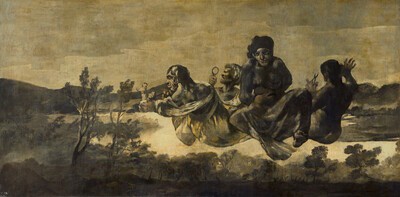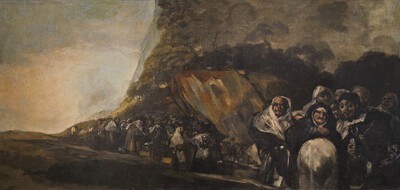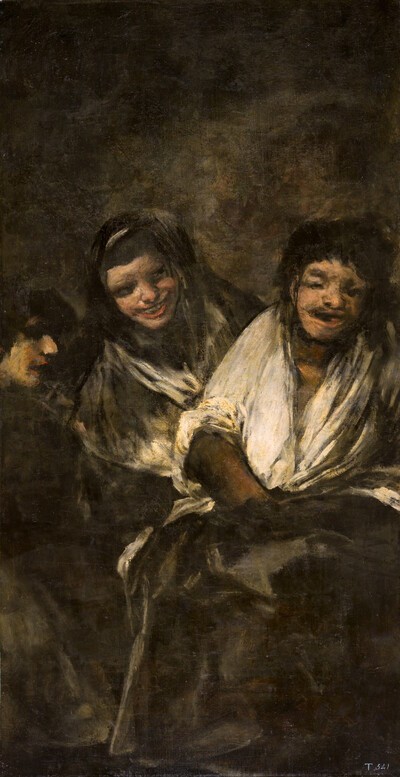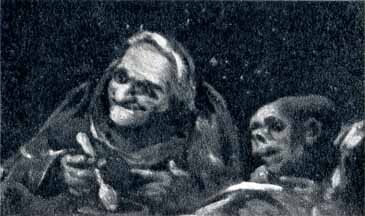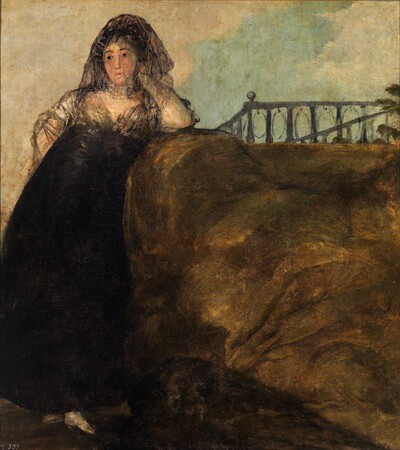- Cronología
- Ca. 1820 - 1823
- Ubicación
- The Prado National Museum. Madrid, Madrid, Spain
- Dimensiones
- 140.5 x 435.7 cm
- Técnica y soporte
- Oil painting on plaster transferred to canvas
- Reconocimiento de la autoría de Goya
- Undisputed work
- Titular
- El Prado National Museum
- Ficha: realización/revisión
- 27 Oct 2010 / 13 Nov 2023
- Inventario
- (P00761)
See Leocadia.
This painting was located on the long wall of the left-hand side of the lower floor of the house known as the Quinta del Sordo, opposite The Pilgrimage to San Isidro.
The painting shows a witches' gathering in the presence of a devil in the form of a male goat, an idea that Goya had already explored in works produced for the Alameda Palace of the Duke and Duchess of Osuna, as well as in prints from the series Caprices (Caprichos) and Follies (Disparates).
The demon presides over the ceremony accompanied by a kind of assistant on his right. On the far right there is a girl awaiting her initiation. The attendants at this hellish gathering form a great mass of figures characterized by deformed gestures and distorted facial expressions conveying the horror and animal instincts that the male goat figure is transmitting to the crowd.
Nordström has attempted to give a symbolic meaning to the painting, linking it with Saturn as the god of melancholy. This relationship is justified by the use of the image of a male goat, the symbol for Capricorn ruled by the planet Saturn.
The composition is focused on the centre of the painting where the crowd of figures is situated, although the work suffered some changes following its removal from the wall. Photographs taken before the paintings were transferred to canvas show that the restorer removed almost a metre and a half of the painting. In the original format the girl sitting down would have been almost in the centre of the composition, and not on the far side of the painting where she sits today.
Black is the predominant colour in the painting, along with some touches of flesh tones, ochres, greens, and dirty greys used for the clothing. The artist used violent brushstrokes and rapid marks in accordance with the expressionist style of the scene.
Apart from the restoration work carried out by Martínez Cubells in 1973, further restoration work was also carried out in 1954 by Pablo y Alarcón for the Prado Museum.
-
Pinturas Negras en la Exposición Universal de ParísPalacio del TrocaderoParís1878from may 20th to November 10th 1878
-
Goya. 250 AniversarioMuseo Nacional del PradoMadrid1996consultant editor Juan J. Luna. From March 29th to June 2nd 1996cat. 155
-
Goya, sa vie, son œuvreParísHenri Plon1867pp. 140
-
Goya. Composiciones y figuras, t.IIMadridBlass1917pp.122-127
-
Goya, Saturno y melancolía. Consideraciones sobre el arte de GoyaStockholmAlquimis & Wiksell1962p.254-255
-
Goya. Las Pinturas NegrasMadridGoya Hispano-Inglesa de Reaseguros, D.L.1963pp. 127-128
-
Vie et ouvre de Francisco de GoyaParísOffice du livre1970p. 328, cat. 1623
-
BarcelonaPolígrafa1970vol. I, p. 378, cat. 700
-
GoyaBarcelonaCarroggio S.A. de Ediciones1974p. 201, cat. 584
-
Goya's Black Paintings: Truth and Reason in Light and LibertyNew YorkHispanic Society of America1984pp. 155-167
-
Las pinturas negrasMadridEdiciones Antiquaria, S.A1996pp. 94-95
-
Goya. Pinturas del Museo del PradoMadridMuseo Nacional del Prado1997pp. 308
-
Las Pinturas Negras de GoyaLondonScala Publishers Ltd.2003pp. 66-67


